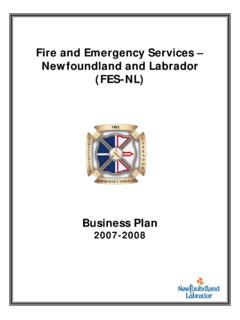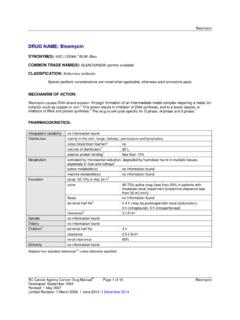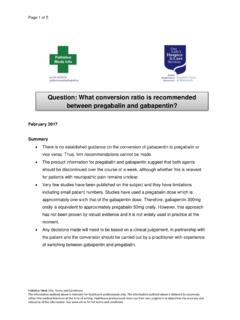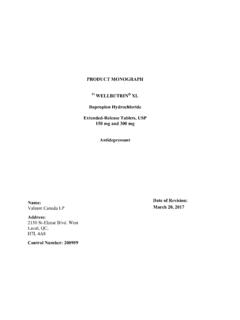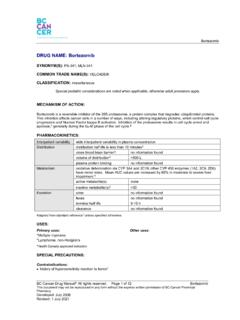Transcription of Standardized Adult (40-130 kg) IVIG Infusion Rate Tables ...
1 NL-IVIG002 Version: P a g e | 13 Effective Date: 2018-04-01 Standardized Adult (40-130 kg) IVIG Infusion Rate Tables Gammagard Liquid 10% For complete product information please refer to product monograph. Rate mL/kg/hr Patient Weight in Kilograms 40 45 50 55 60 65 70 75 80 85 90 95 100 105 110 115 120 125 130 Infusion Rate mL/hr 20 25 30 35 40 45 50 55 60 65 40 45 50 55 60 65 70 75 80 85 90 95 100 105 110 115 120 125 130 80 90 100 110 120 130 140 150 160 170 180 190 200 210 220 230 240 250 260 * 160 180 200 220 240 260 280 300 320 340 360 380 400 420 440 460 480 500 520 MMN only ** 216 243 270 297 324 351 378 405 432 459 486 513 540 567 594 621 648 675 702 240 270 300 330 360 390 420 450 480 510 540 570 600 630 660 690 720 750 780 320 360 400 440 480 520 560 600 640 680 720 760 800 840 880 920 960 1000 1040 *Check with prescriber to ensure the rate may be
2 Increased above mL/kg/hr for each specific patient as those at risk of renal failure or thrombosis may require lower dosages and/or Infusion rates. Recommended maximum Infusion rate for first Infusion . **Recommended maximum Infusion rate for treatment of Multifocal Motor Neuropathy (MMN) is mL/kg/hr . If weight falls between two increments, round down and use rates specified for that weight or calculate hourly Infusion rates by using the following formula: Rate (mL/kg/hr) x Weight (kg) = Hourly Infusion rate (mLs/hr). Perform a DOUBLE CHECK of all calculations. Perform assessment including vital signs at a minimum: pre- Infusion , 15 minutes after Infusion initiated, with each rate increase, upon completion, and then 30-60 minutes post Infusion (minimum observation period of 20 minutes post completion of administration).
3 RHA/site/unit policy may dictate more frequent monitoring during administration of IVIG. NL-IVIG002 Version: P a g e | 14 Effective Date: 2018-04-01 Standardized Adult (40-130 kg) IVIG Infusion Rate Tables For the first Infusion or if greater than 8 weeks since last treatment, it is recommended to initiate Infusion at mL/kg/hr for 30 minutes. Gradually increase rate every 15-30 minutes, as tolerated, according to steps in table. It is not recommended to advance to the maximum rate with the first Infusion . If tolerated well, for subsequent infusions follow the same process beginning at mL/kg/hr rate and increase every 15-30 minutes as tolerated.
4 For recipients who have received IVIG previously for at least 3 doses, without incident, the prescriber may order a personalized rate and/or protocol for future infusions. Recipients who are overweight, immobilized, have a history of hypertension, cardiovascular disease, previous thrombotic events, and/or dehydration are at high risk for thromboembolic events. Recipients with acute renal failure should be administered IVIG products at the minimum concentration and the minimum rate of Infusion practical. Many of the adverse effects associated with IVIG are rate related so simply reducing the Infusion rate may minimize or eliminate these adverse effects. If adverse effects persist, a change in product from one manufacturer of IVIG to another may also increase tolerability.
5 Administration of pre-medications may also minimize adverse effects. Ensure the recipient is adequately hydrated prior to initiation as dehydration can predispose to headaches, thromboembolic events and other adverse reactions. NL-IVIG002 Version: P a g e | 15 Effective Date: 2018-04-01 Standardized Adult (40-130 kg) IVIG Infusion Rate Tables Gamunex , IGIVnex (All 10% IVIG solutions) For complete product information please refer to product monograph. Rate mL/kg/min Patient Weight in Kilograms 40 45 50 55 60 65 70 75 80 85 90 95 100 105 110 115 120 125 130 Infusion Rate mL/hr 24 27 30 33 36 39 42 45 48 51 54 57 60 63 66 69 72 75 78 48 54 60 66 72 78 84 90 96 102 108 114 120 126 132 138 144 150 156 96 108 120 132 144 156 168 180 192 204 216 228 240 252 264 276 288 300 312 144 162 180 198 216 234 252 270 288 306 324 342 360 378 396 414 432 450 468 * 192 216 240 264 288 312 336 360 384 408 432 456 480 504 528 552 576 600 624 288 324 360 396 432 468 504 540 576 612 648 684 720 756 792 828 864 900 936 336 378 420 462 504 546 588 630 672 714 756 798 840 882 924 966 1008 1050 1092 *Check with prescriber to ensure the rate
6 May be increased above mL/kg/min for each specific patient as those at risk of renal failure or thrombosis may require lower dosages and/or Infusion rates. Recommended maximum Infusion rate for first Infusion . If weight falls between two increments, round down and use rates specified for that weight or calculate hourly Infusion rates by using the following formula: Rate (mL/kg/min) x Weight (kg) x 60 min/hr = Hourly Infusion rate (mLs/hr). Perform a DOUBLE CHECK of all calculations. Perform assessment including vital signs at a minimum: pre- Infusion , 15 minutes after Infusion initiated, with each rate increase, upon completion, and then 30-60 minutes post Infusion . RHA/site/unit policy may dictate more frequent monitoring during administration of IVIG.
7 For first Infusion or if greater than 8 weeks since last treatment, it is recommended to initiate Infusion at mL/kg/min for 30 minutes. Gradually increase rate every 15-30 minutes, as tolerated, according to steps in table. It is not recommended to advance to the maximum rate with the first Infusion . NL-IVIG002 Version: P a g e | 16 Effective Date: 2018-04-01 Standardized Adult (40-130 kg) IVIG Infusion Rate Tables If tolerated well, for subsequent infusions follow the same process but begin at mL/kg/min rate and increase every 15-30 minutes as tolerated. For recipients who have received IVIG previously for at least 3 doses, without incident, the prescriber may order a personalized rate and/or protocol for future infusions.
8 Recipients who are overweight, immobilized, have a history of hypertension, cardiovascular disease, previous thrombotic events, and/or dehydration are at high risk for thromboembolic events. Recipients with acute renal failure should be administered IVIG products at the minimum concentration and the minimum rate of Infusion practical. Many of the adverse effects associated with IVIG are rate related so simply reducing the Infusion rate may minimize or eliminate these adverse effects. If adverse effects persist, a change in product from one manufacturer of IVIG to another may also increase tolerability. Administration of pre-medications may also minimize adverse effects. Ensure the recipient is adequately hydrated prior to initiation as dehydration can predispose to headaches, thromboembolic events and other adverse reactions.
9 NL-IVIG002 Version: P a g e | 17 Effective Date: 2018-04-01 Standardized Adult (40-130 kg) IVIG Infusion Rate Tables Privigen 10% For complete product information please refer to product monograph. Rate mL/kg/hr Patient Weight in Kilograms 40 45 50 55 60 65 70 75 80 85 90 95 100 105 110 115 120 125 130 Infusion Rate mL/hr 12 15 18 21 24 27 30 33 36 39 24 27 30 33 36 39 42 45 48 51 54 57 60 63 66 69 72 75 78 48 54 60 66 72 78 84 90 96 102 108 114 120 126 132 138 144 150 156 96 108 120 132 144 156 168 180 192 204 216 228 240 252 264 276 288 300 312 144 162 180 198 216 234 252 270 288 306 324 342 360 378 396 414 432 450 468 * 192 216 240 264 288 312 336 360 384 408 432 456 480 504 528 552 576 600 624 240 270 300 330 360 390 420 450 480 510 540 570 600 630 660 690 720 750 780 288 324 360 396 432 468 504 540 576 612 648 684 720 756 792 828 864 900 936
10 *Check with prescriber to ensure the rate may be increased above mL/kg/hr for each specific patient as those at risk of renal failure or thrombosis may require lower dosages and/or Infusion rates. Recommended maximum Infusion rate for first Infusion . If weight falls between two increments, round down and use rates specified for that weight or calculate hourly Infusion rates by using the following formula: Rate (mL/kg/hr) x Weight (kg) = Hourly Infusion rate (mLs/hr). Perform a DOUBLE CHECK of all calculations. Perform assessment including vital signs at a minimum: pre- Infusion , 15 minutes after Infusion initiated, with each rate increase, upon completion, and then 30-60 minutes post Infusion .

